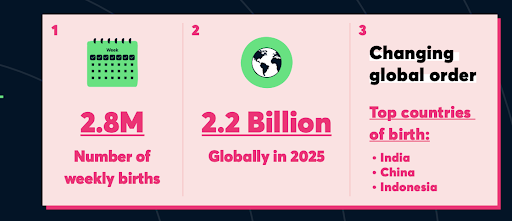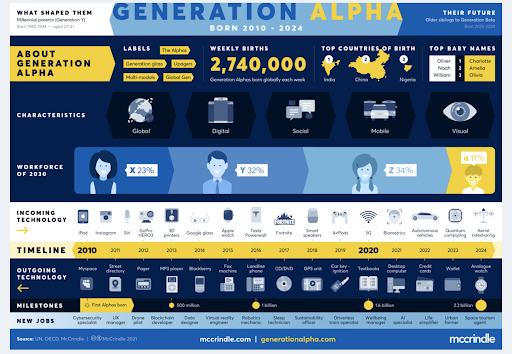As with all things technology, social media innovates and evolves at a dizzying pace.
Driven by prosumerism, the changes to social media platforms are often defined by the users themselves- as the demographics change, so too does the user behavior and, with it, the platforms themselves.
From the birth of Facebook in 2004 to the more recent introduction of video content creation apps such as YouTube, TikTok, and Instagram, sometimes it can feel like our lives revolve around this social world.
However, data analysis shows that every generation, from baby boomers to millennial parents to the digital natives of the younger generation, interacts with social media differently.
It is crucial that digital publishers and advertisers remain across who is interacting with their content, how, and why.
As Mark McCrindle, author of Generation Alpha, bluntly states, ‘if organizations want to not only exist in a decade’s time, but thrive and flourish, then understanding Generation Alpha is imperative.‘
It is predicted that Generation Alpha, the first generation of people born entirely in the 21st century, may spend more than eight hours a day on social media when they come of age in the next two decades.
So who are generation Alpha, the generation born into a world of digital technology, and what do Publishers need to know about these young people whose increasing social media usage will drive us into a whole new world of social publishing?
Who Makes Up Gen Alpha?

Born between 2010 and 2025, Generation Alpha is the successor to Generation Z and are primarily the children of millennial parents. Gen Alpha children significantly influence household purchases, and Gen Alpha parents are characterized by their tech-savviness and openness to new digital trends. In the US alone, a new Gen Alpha baby is born every 9 minutes in the US alone, with predictive data showing that they will outnumber the Baby Boomers within four years.
This technologically infused demographic will be the first to grow up with AI, social media, robotics, and mobile devices fully integrated into their daily lives.
As a result, they will be not just digitally literate but technologically savvy. Many of them will live to see the 22nd Century; they will stay in education longer and will be the most materially endowed generation to date.
Already making up 1 in 7 people globally, this new generation is growing up in a world of increasing individualization and customization. They can have their name printed onto a book, a doll, or a jar of vegemite if they so desire it.
They have buying power and influence well beyond their years and are already shaping the way we build businesses.
Social Media, Gen Alpha, and the Changing Digital Landscape

In what has always been a content-consuming world, we have already seen the effects of exponential growth in social media on how we consume news, sell products and interact with our fellow human beings.
As they say, past behavior is the best predictor of future behavior. Here is what the researchers are telling us about generation alpha and social media. To catch and keep Gen Alpha’s attention, it is crucial to focus on authenticity, interactivity, and gamification.
Time Spent on Social Media Platforms
Time spent on social media platforms has steadily increased since its introduction to the digital ecosystem. Social media use in the US grew from 90 minutes daily in 2012 to 153 minutes daily in 2019.
Forecasting predicts that up to 21% of generation alpha will spend more than eight hours a day on social media in the future. Children receiving smartphones at a young age significantly influences how Gen Alpha interacts with mobile devices, shaping their engagement with social media.
However, it’s not just the amount of time spent on social media that will evolve with the coming generation, but also how and why they interact with these platforms.
Types of Social Media Platforms
For those in Generation Alpha who are already using social media, the trends are clear.
While previous generations favored sites such as Facebook and Twitter, younger generations embrace an influencer world driven by video apps.
Generation Alpha are far more likely to be found on visual apps such as TikTok, Instagram, and Snapchat. These ‘iPad kids’ have had early exposure to and reliance on tablets such as the iPad, especially accelerated by the COVID-19 pandemic and the need for remote learning. Social media sites that embrace the latest in technology will most likely retain the attention of the digital natives that make up Generation Alpha.
Generation Alpha Will Be More Trusting

When we look back at older generations, many people were hesitant to trust news updates on their social media feeds- the key barriers to this being concerns about fake profiles, privacy, truth, and security.
In contrast, Generation Alpha will be the most trusting of their peers on social media compared to their predecessors. Older Gen Alphas, in particular, are showing increased social media usage and are beginning to influence household purchases significantly.
The upcoming generation will be more likely to trust reviews and recommendations found on social channels, and almost 50 % of them will consume news on social media, as opposed to just over 15% of Baby Boomers.
Data Privacy Will Increase
While the next generation may be more trusting when it comes to what they read online, they will most likely be less unsuspecting when it comes to their data and who they share it with.
With awareness already increasing around data privacy along with the impending death of third-party cookies, by the time this age group matures, they will most likely have a far more profound understanding of these privacy issues than previous generations. Additionally, understanding and addressing the mental health and wellness of Gen Alpha will be crucial, given the negative impacts of media overconsumption and the addictive nature of social media.
eCommerce Will Boom
Over the last few years, we have seen social platforms like Instagram and Facebook add selling channels for businesses.
While this pivot has seen impressive growth, older generations remain hesitant to purchase via these platforms. This will differ significantly with the next generation, with predictions showing 28% of Generation Alpha will use social media to shop, as opposed to the 5% of Gen Z we see now. Gen Zers, while already adopting social media and technology at a rapid pace, still show a lower percentage of social media shopping compared to the anticipated habits of Gen Alphas. This could significantly impact independent businesses and high street retailers, who don’t embrace social media as an e-commerce platform.
Purchase Inspiration Will Evolve
It may not be enough for publishers and advertisers to understand how and where Gen Alpha will shop- They need to consider why they will shop; what tactics will drive them to make a purchase.
A recent future shoppers survey by Wunderman Thompson Commerce uncovered some valuable insights into Generation Alpha purchase inspiration.
The survey found that the content most likely to influence Gen Alpha’s desire to buy something is online video. Advertising via channels such as YouTube and TikTok was found to be far more effective than TV adverts. However, it is important to note that social media usage has been linked to negative effects on the mental health of adolescents and young adults, including increased depressive episodes and decreased self-satisfaction.
In addition, the research found Gen Alpha to be heavily affected by influencers, with more than half (55%) of respondents saying ‘they would want to purchase a product if they saw their favorite Instagram or YouTube star wearing or using it.’
Case Study: The Week Junior

Launched in the US in March 2020, The Week Junior is a weekly news subscription magazine. Designed specifically for 8-14-year-olds, The Week Junior was developed to provide ‘the facts behind what’s happening in the world and empowering Gen Alpha to develop and voice their own point of view‘.
This Generation Alpha targeted publication clearly understands its target market, integrating several initiatives and platforms into its publishing strategy.
The Week Junior offers two interactive franchises for readers themselves to get involved- The Big Debate, which allows kids to weigh in on the weekly news, and Junior Council, which trains young reporters. The impact of technology and social media on youth, including their attention span and socialization, has been significant, with many students expressing a dislike for online school during the pandemic and preferring activities that don’t involve being ‘stuck on a screen.’
More than just a website, they promote engagement across Facebook, Instagram, Twitter, and Pinterest (for parents), as well as PopJam (for kids).
Content from our partners
The success of this publication with people born into the Alpha Generation is evident. The Week Junior has enjoyed impressive growth since its inception, now reaching over 100 thousand households.
Case Study: The Daily Aus
Founded by two Australian Gen Z journalists, The Daily Aus started as an Instagram page sharing news for Gen Z and Generation Alpha. Since then, they have grown into a fully independent news website with community management.
The Daily Aus is clearly targeted at and developed for a different age range than typical news websites.
They are funded by revenue from partners in their daily podcast and newsletter and only partner with brands who believe in and are aligned to their company ethos.
Their website describes the Daily Aus as being run by ‘two twenty-somethings who decided they’d make a business out of explaining the news to their friends’. This perfectly sums up the changes to how people find news updates today.
And their strategy is clearly working, with their website announcing they have just completed ‘their first capital raise with incredibly diverse and talented investors’, none of who have the ability to affect the editorial content or direction.
By tapping into the changing digital landscape and leveraging podcasts, Instagram, and TikTok to deliver the news to a changing demographic, they will no doubt see even more exponential growth in the future. Compared to other generations, Gen Alpha faces unique mental health challenges due to the pervasive influence of digital media.
Final Thoughts
With no sign of the social world slowing down and Generation Alpha knocking on the door of adulthood, publishers, advertisers, and social platforms all need to be looking at how they can cater to this generation, who, within four years, will be the largest generation in the world.
With research in the US suggesting that four out of five Gen Alpha kids significantly influence family purchases, digital marketers should be tailoring their strategies to this already tech and brand savvy generation. As mobile usage increases, it is becoming more common for children to receive a smartphone at a young age, and this exposure to mobile devices shapes how Gen Alpha interacts with the world.
Furthermore, social media now have a greater responsibility than ever before to ensure its platforms positively influence their users’ lives. By doing more to mitigate the effects of fake news, fake profiles, and fake reviews, social sites can ensure they don’t see diminished returns through decreased trust.












